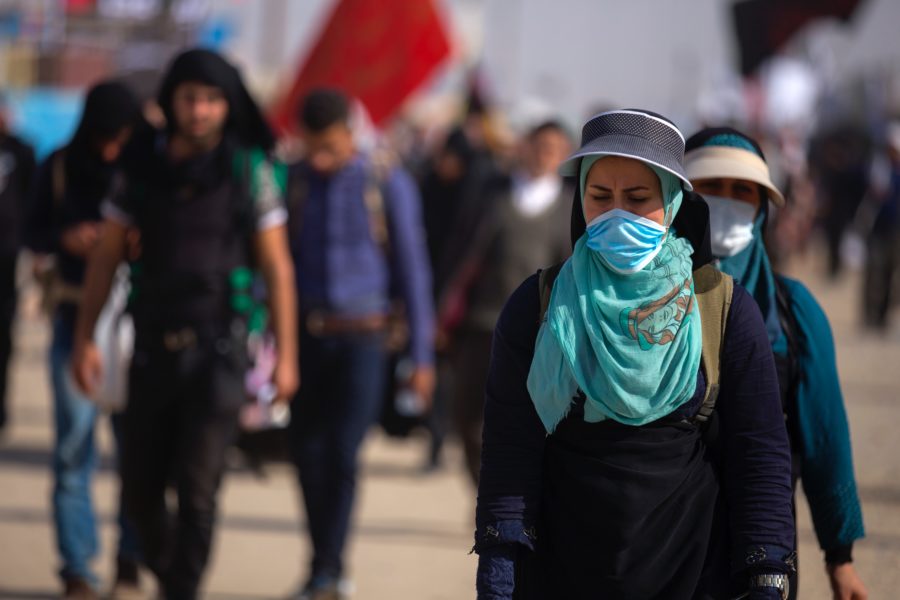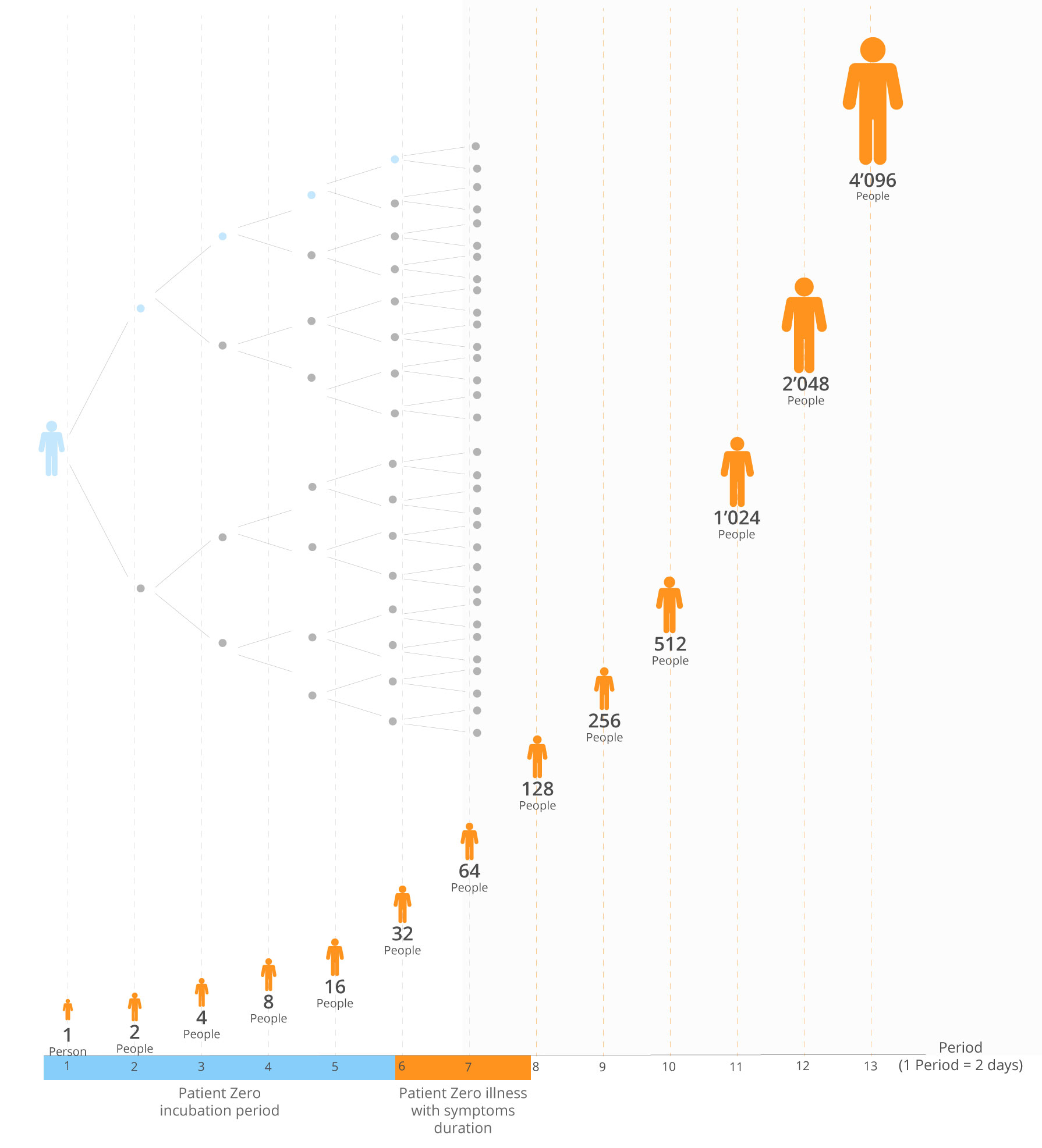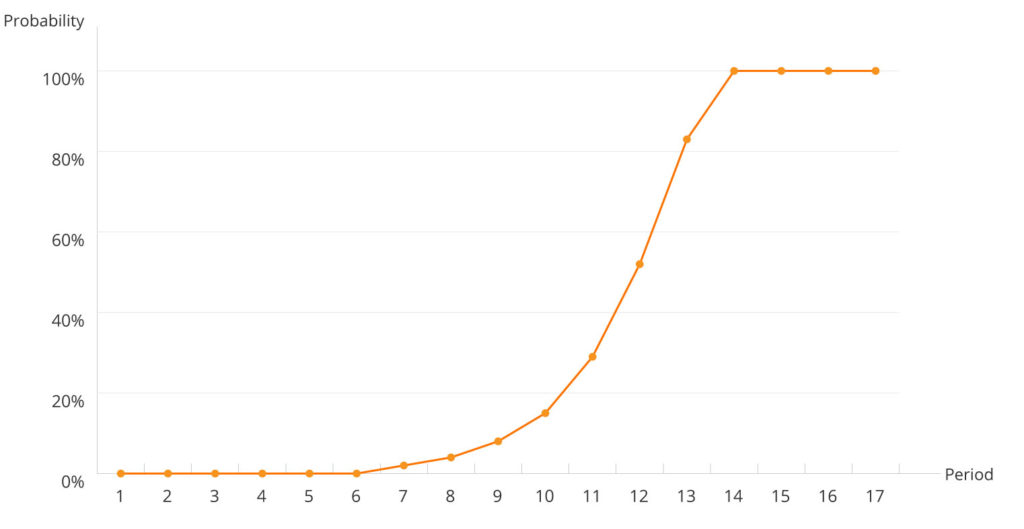
This blog article is a translation of the blog article written on Februar 25, 2020 (in German). Because of high demand, we decided to publish a translation of the German version.
The number of cases often increases explosively over the few days following the detection of the coronavirus in a country. This happens especially when the trace of the virus has been lost, and no one knows where and whom to test. For this reason, the spread of the virus is best demonstrated using an example. Unfortunately, it turns out that by the time the first case is identified, there is a strong possibility that so many cases exist that it is already too late for a containment strategy – or extreme measures to limit the further spread. The example shows that when the first case is detected, more than 4,000 people are already unknowingly infected.
By that time, virus reporting was mainly focused on China, South Korea, and Japan, and this news passed by without comment for a long time. But hold on – where are all the infected people? One day later, the first eight confirmed cases were uncovered, and Bloomberg concluded that the mortality rate in Iran would be 20% (the article was quickly deleted, as it was obviously wrong).
The actual mortality rate still remains unknown (see my article on the mortality rate), as the real rate can only be revealed after either the epidemic is defeated, or significant progress is made. Currently, the number of deaths in China has rapidly increased, while the number of newly infected decreases (which increases the mortality rate, according to the standard calculation).
In the meantime, it became known that children, for example, rarely show any symptoms of the disease – although they are carriers of the virus. Furthermore, there are generally many people with only mild or no symptoms (again suggesting that the mortality rate is significantly lower than it is officially classified). Apparently, the total number of Covid-19 confirmed cases represents an unreliable value, as it can only be confirmed if it can be measured. No one knows how many asymptomatic cases are to be revealed, or the real numbers of those who are still in the incubation period.
A relatively reliable value is the number of people who have already died of Covid-19. It also applies to Iran, as on Wednesday, February 19th, 2020, two coronavirus victims were reported dead. The two infected were actually the only deaths: in this case, the mortality rate should be 100%. Reasoning from this fact, a range of 2,000 infected people can lead to a mortality rate of 0,1%: two alternatives result of two deaths. The truth lies somewhere in the middle.
Now, if we assume that a realistic mortality rate is 2%, then it makes 2/0,02= 100 infected. However, that would only be a case if the crisis was over. But it is not, as the outbreak in Iran is (probably) still at its early stage. Meanwhile, we know that the incubation period is up to 24 days, and the virus can disseminate during this period. It means, that there are many people, who have not died yet and still have not been cured, but already carry the virus. How many of them are there?
Let’s take a closer look on the following theoretical example:
Mortality rate: 2%
Incubation period: 10 days (conservative assumption)
Moving forward, we assume, that an infected person (patient zero) infects another person every 2 days. Hence, 5 more people fall under the incubation period. After the incubation period is over, the patient zero becomes ill and stays sick for the next 4 days. These 4 days are also more of a conservative assumption – it’s normally 6-7 days. The ill patient remains contagious during this period of time (it was recently revealed that 3,000 nurses in China were infected). At the end of this period (7 days) there is a 2% probability of the patient dying, or a 98% of recovery respectively. The health system of the country in the example is relatively weak, and the virus can only be detected in lethal cases.
Question: We observe a dead person. How many infected should we expect?
In order to answer this question, we model a binomial tree, whereby a step in a binomial tree equates to 2 days (2 days = 1 period). The number of infected per period increases according to the following series: 1,2,4,8, etc. At the end of the incubation period (period 5), 16 people are infected. After another 4 days (2 periods), there are 64 infected. It is also a point, when the first patient (patient zero) reaches the critical point that determines their life (death/recovery). They have a 2% chance to die, and a 98% chance to recover from the disease (the virus remains undetected in the second case). There is a high probability that the virus will still not be detected in Period 7.
Diagram: Corona virus spread

One period later, there are already 128 infected. Patient Zero has either recovered or died. Now the second person (who got infected from patient zero in period 2) reaches the point where they either die, or recover from the disease. Hence, there are 2% more added to the probability of another death (mathematically it is not an addition, but for small values, this statement is roughly correct). In Period 9, there are 2 more patients in this condition, in Period 10 there are 4 more, and so on. At this point, the number of patients who could potentially die increases pretty quickly.
The probability now of one patient actually dying, and the disease therefore being detected (E), is 1-ND, i.e. 1 minus the cumulative probability that the disease will not be detected. The probability that someone will die and the disease is detected increases progressively after period 7. In Period 12, there is a 50% probability that someone has already died. At this period of time, in this example, there are 4096 infected(!), but which remain undetected.
| Period 1 | Period 2 | Period 3 | Period 4 | Period 5 | Period 6 | Period 7 | Period 8 | Period 9 | Period 10 | Period 11 | Period 12 | Period 13 | |
|---|---|---|---|---|---|---|---|---|---|---|---|---|---|
| Number of infected | 1 | 2 | 4 | 8 | 16 | 32 | 64 | 128 | 256 | 512 | 1024 | 2048 | 4096 |
| Number of patients who could die | 1 | 1 | 2 | 4 | 8 | 16 | 32 | ||||||
| Probability of virus undetection (per period) | 100% | 100% | 100% | 100% | 100% | 100% | 98% | 98% | 96% | 92% | 84% | 68% | 36% |
| Accumulated probability of virus undetection |
100% | 100% | 100% | 100% | 100% | 100% | 98% | 96% | 92% | 85% | 71% | 48% | 17% |
| Accumulated probability of virus detection | 0% | 0% | 0% | 0% | 0% | 0% | 2% | 4% | 8% | 15% | 29% | 52% | 83% |
| Patient Zero incubation period |
|||||||||||||
| Patient Zero illness with symptoms duration |
|||||||||||||
Whether this example precisely depicts reality or not is eventually unimportant. What I would like to underline with this example is that when there is one dead of coronavirus, there can be hundreds, or even thousands, infected. This could also explain the blast of new cases in China, South Korea, or Japan. It happens whenever a trace of the infection is lost, and patient zero (and everyone around them) does not know that he/she is a virus carrier. If you come up with a reasonable suspicion and start testing in this area, you will come up with a whole bunch of untested cases. Therefore, it can be assumed, that many more cases (infected and dead) will appear in Iran – and probably also in Italy – in the next few days. At this moment (Mo., 24.02.2020) in Iran, there are 61 «confirmed cases» and 12 «deaths», which still corresponds to the mortality rate of 20%, if calculated traditionally. It shows that something is wrong.
Back to the above-mentioned example, if one death approximates 4,000 infected, then 12 dead indicates there are many more cases of infection. Allah Akbar!
Diagram: Probability of a corona virus detection

So far, similar to the seasonal influenza, it was assumed that virus transmission would be more difficult in warm weather, and that the virus would disappear on its own. A temperature overview, in Iran today around (12-26C) or in a strongly affected metropolis Singapore (26C), does not seem promising, because apparently the virus spreads quite well even at higher temperatures.
Under such conditions, it is incredibly difficult to handle the outbreak, as the moment of suspected infection occurs late. Possibly, the fight against the virus has already been lost through containment, and Covid-19 is already out of control.





Leave Comment